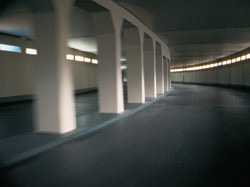What does an artist’s studio look like? There is, of course, no single answer. Just as artists work in increasingly varied media, so do their studios differ in size, shape and function. They might range from a single computer screen to a traditional painting room. Thomas Demand is somewhere in-between. Situated close to the Mitte district of east Berlin, just by the Hamburger Bahnhof art museum, it occupies part of a large red-brick warehouse, with loading doors at one end and a bank of windows raised high above head height along both sides. Inside, it is surprisingly empty. On one side there is a neat desk with some of the tools of his trade: Stanley knives, a cutting mat, pens, set squares and rulers, tubes of Uhu glue and cans of Spray Mount and Dust Off Plus. In the centre sits the partial remains of a model made for his recent work Gate 2004.
Demand’s large photographs, some measuring up to three by four metres, are the culmination of months of preparation involving various stages of careful production. Unlike more conventional photographers who tend to capture what already exists in the world, Demand creates his own world – out of paper or cardboard. For more than ten years, he has been constructing often life-size paper versions of familiar objects and environments: an office interior, a staircase, a diving board, a Venetian blind, an autobahn. This requires an extraordinary amount of time and manpower – it can take a year to make five pieces. For one of his most recent pieces Clearing 2003, a complex reconstruction of a woodland glade, he worked with 30 assistants over three months.
There is no immediate logic to his choice of subject matter, and he has said that he ‘doesn’t assume any hierarchy in the original of these images’. However, there is often a potent political or historical subtext. Podium 2000, for example, is an image of a lectern – like the one from which Slobodan Milosevic made a speech on the 600th anniversary of the Serbs’ defeat by the Turks. Room 1994 is based on the image of the ruins of Hitler’s bunker, while Barn 1997, showed the dark interior of Jackson Pollock’s last studio in Long Island.
For his most recent work, Demand wanted to find an object that was ‘so quirky that you don’t really know what it is’. And he discovered his source in an unlikely place – a poetic chance encounter while on holiday in Thailand. ‘In my wooden hut I found a book on space travel on the bookshelf,’ he says. ‘It had this amazing image of a space-travel simulator. On one hand it looked like something recognisable, because the context was clear. But on the other hand it looked like some kind of mistake – like a crumpled piece of paper, or a Frank Gehry building that hadn’t been finished.’
Having decided on his subject, he may do a few drawings, but doesn’t feel the need to produce detailed plans: ‘I am going to be stuck making this thing for three months, so I think through every detail of it. I know exactly how I want it.’ Unusually though, in the case of Space Simulator he built a small maquette, borrowing snippets of information from an Airfix diagram of a space capsule.
After this he chooses the paper. ‘The colour is very important,’ he says.’
The thing about the simulator is that you can’t really date it. So I needed to have a colour that is like those computers you see in old pictures. It couldn’t be green – because NASA used a lot of green once. So I chose beige, but I made it a little darker in order to get close to a sort of Cubist colour. We couldn’t buy paper in that colour, so, for the first time, we had to get it specially printed.
There are strong associative memories, he feels, with a material that we all use – from days spent on school projects to the simple act of crumpling a sheet of paper: ‘We know the surfaces, so we have a whole set of experiences about it, whereas fewer people have those experiences with paint.’
When Demand first began building his models, he thought they should be ‘as seamless as possible’, but then decided that ‘the imperfection is the beauty of it’. This forms part of what becomes our multi-layered response to the finished photograph.’The viewer looks at it and it’s exciting, but at the same time as enjoying it, he or she realises that the whole thing might fall apart. Then there is the realisation – the amazement that this thing is handmade.’
His large-format camera is set up on a tripod and remains in position as the model takes shape, so that he can ‘keep looking through from the camera’s perspective’. With Gate, a convex mirror was attached to the tripod to avoid having constantly to go up and down the ladder. The quality of light in his pictures is crucial – from the flat light in Office 1995, to the rays of sunshine that break through the trees in Clearing. While this often looks natural, Demand almost exclusively uses artificial lights set on a framework of rigs around the model.
The taking of the final photographs signals the end of the life of the model. When Demand first began working as a sculptor, the models he made were the works of art. Now their function has changed, but he still finds it difficult not to become attached to them during their short existence, and it’s never easy to throw them away. But once the last sections have gone out of the door, it is time to think about the next subject – and the next choice of paper.

